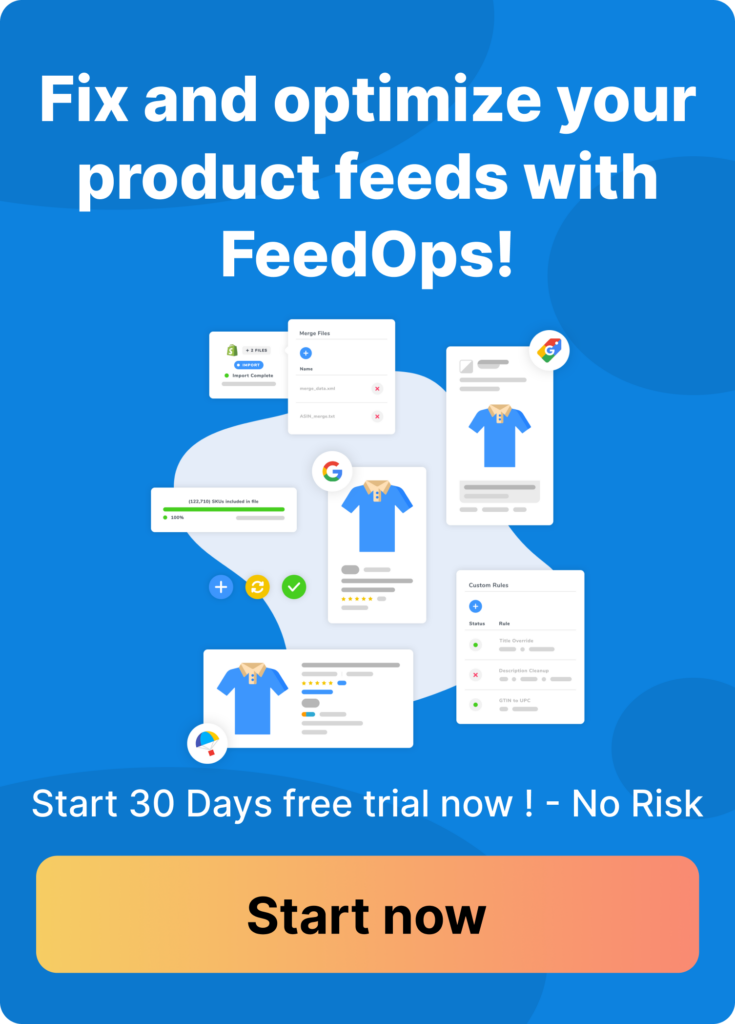When it comes to successful digital marketing, feed optimization plays a crucial role. By fine-tuning your product feed, you can enhance product visibility, boost click-through rates, and ultimately drive more sales. If you’re using FeedOps, a feed optimization tool built for everyday digital marketers, knowing some advanced techniques can significantly improve your results. In this guide, we’ll delve into four selected areas that can make a real difference to your optimization efforts.
Contents
Ensure All Relevant Attributes Are in Your Feed
Attributes fundamentally define your product’s characteristics, making them understandable to both potential customers and the AI of ad platforms like Google, Microsoft, and Meta. Attributes might include specifics such as color, size, material, brand, and more. The more accurately and comprehensively you represent your product’s attributes, the better its discoverability and appeal in the marketplace.
Let’s consider two examples for clarity: socks and smartphones.
For socks, relevant attributes could be size, material, color, pattern, and brand. For instance, a pair of socks could be described as a large, cotton, red, argyle pattern, manufactured by Brand X.
On the other hand, a smartphone has an entirely different set of attributes. These could include brand, model, storage capacity, color, screen size, operating system, and so on.
It’s essential to note that it’s common for some attributes to be missing on a website because they’re not always necessary for the consumer’s understanding. For example, if the pattern of a sock (like Argyle) is perfectly visible in the image on your website, it may not be necessary to add it as an attribute. However, for feed optimization and advertising, these details can be beneficial.
Some attributes are mandatory, some are optional, and others are conditionally required depending on the product. It’s crucial to focus on attributes that are most relevant to your products and audience. By ensuring all relevant attributes are present in your feed, you can make your products more attractive to your target audience, and also enhance their performance in ad platforms’ algorithms.
However, we understand that this process can seem overwhelming, especially if you’re new to it. Remember, you’re not alone in this journey. If you find any of this confusing or need help understanding which attributes are essential for your specific products, please don’t hesitate to reach out to us. Book a meeting or contact us – we are here to help. Let’s work together to get your product feed optimized for the best possible results.
Map Your Google Product Categories
The Google Product Category is a fundamental attribute used by several advertising channels, including Google, Microsoft, and Meta. You might be wondering, why do these other platforms use Google’s taxonomy? Well, Google’s Product Category taxonomy has become the industry standard for categorizing products, and other platforms have adopted it for consistency and ease of use.
The primary purpose of Google Product Categories is to classify products in various shopping tabs like the Google Shopping Tab, Bing Shopping Tab, Facebook Shops, and Instagram Shopping. However, these categories aren’t just for organizing products; they serve a crucial role in the AI-driven matching of your products to potential customers.
Google does a reasonably good job of auto-mapping product types. It can recognize and categorize many products effectively, which aids in placing your products in front of potential buyers. However, to maximize the benefits of other platforms like Microsoft and Meta, we recommend a more hands-on approach.
By manually reviewing and mapping your product categories, you ensure they are categorized accurately and optimally. While doing this for each product item is the most effective, even doing so at the category level can lead to significant improvements.
Review your product categories, make adjustments as needed, and ensure that they align accurately with the Google Product Category taxonomy. This process might take some time and effort, but the impact on your product visibility across multiple ad platforms can be substantial.
Remember, we’re here to assist if you find any of this confusing or need help understanding how to map your product categories effectively. Book a meeting or contact us – we’re here to help you make the most of your feed optimization efforts.
Aim for Product Type Depth of 3 to 5 Levels
Understanding the distinction between your website’s product categorization and Google’s product categories is crucial. It’s essential to remember that product types are your way of organizing your website. They are free-form, allowing for flexibility and creativity in how you present your products to your website visitors.
On the other hand, Google Product Categories are a fixed and rigid taxonomy used across advertising platforms for consistency.
It’s crucial to note that product types in your feed don’t necessarily need to match your website’s categories. When designing your website, the user experience once they arrive at your site is paramount. It’s perfectly acceptable to categorize your products as “Just In” or “Hot Deals” to capture your customers’ attention and entice them to explore further.
Moreover, it’s not uncommon for a website to have complex category hierarchies, with products falling under multiple categories. However, when these product categories are translated into a product feed, they don’t always provide the ad platforms’ AI with the best possible information.
Best practice recommends a product type depth of 3 to 5 levels that accurately describes your products. Consider, for example, a red Chesterfield Sofa that’s on sale listed under your website’s “Hot Deals” section. When translated into a product type in your feed, a structured 5 level product type like ‘Furniture > Living Room > Sofas > 3-Seat Sofas > Chesterfield Sofas’ gives a more descriptive and accurate categorization for ad platforms to work with.
Remember, optimizing your product types for advertising channels is a different task from optimizing for website user experience. The more accurately you can describe your products in your product feed, the more effectively the ad platforms’ AI can match your products to potential customers.
As always, if you find any of this confusing or need assistance in structuring your product types, book a meeting or contact us. We’re here to help guide you through the process of feed optimization.
Incorporate Keywords in Your Title, Descriptions, and Product Types
Keywords play a pivotal role in enhancing the visibility of your products on advertising platforms. Including relevant keywords in your title, descriptions, and product types can greatly improve the matching of your products to potential customers.
Let’s return to our example of the red Chesterfield sofa. We’ve already created a descriptive product type hierarchy: ‘Furniture > Living Room > Sofas > 3-Seat Sofas >Chesterfield Sofas’. Now, we need to craft a title and description that are both compelling to customers and beneficial for AI matching.
An optimized product title could be something like: “Luxurious Red Chesterfield Sofa – Vintage Inspired Design”. Here, we’ve incorporated essential keywords (“Red”, “Chesterfield Sofa”) and added descriptive terms (“Luxurious”, “Vintage Inspired Design”) to make the title more attractive and informative.
Next, a keyword-rich product description might read: “Embrace timeless elegance with our luxurious red Chesterfield Sofa. Featuring a vintage-inspired design and quality craftsmanship, this sofa adds a bold touch of color and classic style to any living room. Its deep button tufting, scrolled arms, and rich red upholstery create a stunning centerpiece for your home decor.”
In the description, we’ve reiterated key terms, provided more detail about the product, and evoked an image of how the sofa could fit into a buyer’s home.
Remember, your product title and description are not just about stuffing in keywords. They need to be engaging and informative to persuade potential customers to click and learn more.
If you’re unsure about how to include keywords in your product data, don’t hesitate to reach out. We’re here to help guide you through this essential aspect of feed optimization. Book a meeting or contact us today.



